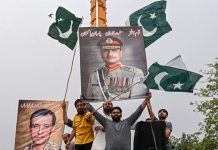With India going to establish an ‘Energy Centre’ in Moscow next month, the traditional importance of defense items in India-Russia relations is on the way of becoming secondary to that of energy partnership between the two countries.
Ladakh Lessons – India Must Learn To Decipher China’s ‘Unpredictable & Secretive’ Foreign Policy
During the just-concluded visit of Indian Foreign Secretary Harsh Vardhan Shringla to Moscow ( 17-18 February 2021), which was carefully chosen to be his very first foreign visit this year, premium time was devoted to “the India-Russia Foreign Office Consultations” towards substantial investments in each other’s energy sectors, including looking at new opportunities for the supply of Russian coking coal for the Indian steel sector.
“Given the significance we attach to the India-Russia Special and Privileged Strategic Partnership, it is only fitting that Moscow is the destination for my first visit abroad in 2021”, Shringla said.
While nuclear cooperation between the two countries is on a firm footing (Russian atomic energy giant Rosatom building six nuclear power plants in India and India has agreed to commission 12 Russian-designed nuclear reactors in the coming years), the new emphasis is on Indian investments in Russian Far East (Siberia region) for oil, gas, timber and cooking coal and then shipping them back to India.
And this is in accordance with the shared vision of Prime Minister Narendra Modi and Russian President Vladimir Putin, the vision they had envisaged in September 2019 at Vladivostok. They had adopted a five-year road map to establish a “Far Eastern Energy Corridor” that would boost Russian oil, gas, and coal exports to India.
It may be noted that Modi is the first Indian Prime Minister to have ever visited Russian Far East. He was there as the Chief Guest of the three-day Eastern Economic Forum, the fifth in the series, that President Putin had hosted.
The then-Japanese Prime Minister Shinzo Abe was also a prominent invitee. In fact, Putin encouraged joint India-Japan collaborations in the exploration of the region so that more Russian exports could be unlocked to these two countries that are among the largest consumers of energy in the world.
It was in this meeting that Modi had pledged a $1 billion credit line from India for developing the Russian Far East.
As of now, Indian companies have significantly invested in Russia. India’s investment in the Sakhalin-1 project was one of its earliest public sector investments abroad. OVL (ONGC Videsh Limited, a subsidiary of ONGC) has been part of the international consortium on the development of the Sakhalin-1 project, which is being implemented on the basis of a production sharing agreement.
Prime Minister Shri @narendramodi had a telephone conversation with H.E. President Vladimir Putin of the Russian Federation today.
Link for Press Release -> https://t.co/2wAF0YHa5W pic.twitter.com/GKwWlJy3ne— India in Russia (@IndEmbMoscow) July 2, 2020
Though initially there were some hiccups in exporting the gas produced there due to the lack of the necessary capacity to liquefy the gas and the drawn-out conflict between Rosneft (OVL’s partner in the Sakhalin project) and Gazprom, which wanted to protect its gas export privileges, things have been sorted out.
Similarly, though earlier attempts by Indian oil companies to become part of other major projects in Russia – the development of the Shtokman Field, the Trebs and Titov Oil Fields, and Yamal LNG – had failed either because of strict Russian regulation with regard to direct foreign investments into strategic industries (including the oil and gas industry) or due to competition from richer and better-equipped companies from China and the West, the breakthrough was made subsequently with OVL’s purchase of a 15 percent stake from Rosneft in Vankor Field for $1.27 billion. Subsequently, OVL has made a further acquisition of 11 percent in the project.
Rosneft, OVL’s partner, has been consistently trying to increase the shares in other oil fields in the region by forming a consortium of Indian investors such as Oil India, Indian Oil Corporation, and Bharat Petro Resources.
To date, Indian oil and gas companies have acquired stakes in 5 Russian companies/projects at a value of about $15 bn. Rosneft, as the leader of a consortium of investors, has acquired a 98% stake in India’s Essar Oil that owns the Vadinar refinery in Gujarat, India’s second-largest.
In fact, the Modi government is seriously into looking at the process of privatizing many of the oil majors and some are having very serious discussions with Russian companies to see if some of these stakes can be acquired by Russian companies. Likewise, Delhi is looking at long-term arrangements for the supply of coking coal from Russia for Indian steel plants.
It may be noted here that one of the reasons for the non-realization of the vast potentials in this far-flung part of Russia is the lack of suitable connectivity for exports. Realizing this handicap, India and Russia are now working on a priority for durable alternatives to the limited and expensive traditional routes in the forms of the International North-South Transport Corridor and the Eastern Maritime (Chennai-Vladivostok) Corridor. These are expected to overcome the logistical challenges posed by geographical distance.
They have already started a shipping line between Vladivostok and Chennai, a new trade route (taking 24 to 25 days to be covered), which was never there.
The International North-South Transport Corridor (INSTC) is the ship, rail, and road route for moving freight between India, Russia, Iran, Europe, and Central Asia. This project, the brainchild of India, Iran, and Russia, was signed on May 16, 2002, but is far from complete. India attaches high priority to it, for it will prove to be the linkage between its Look East-turned Act East and Look West policies.
INSTC will be a multi-modal transportation route linking the Indian Ocean and the Persian Gulf to the Caspian Sea via Iran, and then onwards to northern Europe via St. Petersburg in Russia.
As has been noted, in all this exploration of Russian minerals and development of the necessary infrastructure, India is also seeking Japan’s cooperation and partnership, which, in turn, has been encouraged by President Putin. In fact, the first Track-II Dialogue on ‘India-Japan-Russia Cooperation in the Russian Far East’ was held In January 2021 in the virtual format. It has identified potential areas for trilateral cooperation.
And these collaborations could also extend to the Arctic region, one of the world’s richest sources of minerals, including oil and gas. Russian energy firm Gazprom Neft and others have already expressed interest in working with India.
Russian gas producer Novatek firm is now working on a new Arctic LNG 2 project and plans to work on the future project, Arctic LNG 3. It is estimated that Arctic LNG 2 will have a capacity of 19.8 million tons of LNG per annum when it becomes operational in 2022-23.
As an observer country in the Arctic Council, India is keen on greater engagement with Russia in the Arctic region. It is already an active participant in the “International Arctic Forum” being organized by Russia. In fact, India is looking forward to Russia’s chairmanship of the Arctic Council later this year.
Highlights from visit of Foreign Secretary @harshvshringla from his official visit to #Moscow.#дружбаदोस्ती@PMOIndia @DrSJaishankar @MEAIndia @IndianDiplomacy @mfa_russia @RusEmbIndia @DDNewslive @DDIndialive @ANI @ani_digital @WIONews @PTI_News pic.twitter.com/RdHoi1bu2C
— India in Russia (@IndEmbMoscow) February 20, 2021
Strategic analysts say that Russia wants India’s investments in its Far East and the Arctic because many Western investors are reluctant to finance projects in the Russian energy sector and Russia does not want to be over-dependent on China for this purpose.
All told, Russia and China have been geopolitical rivals for ages and the former is always worried about the heavy Chinese immigration to its sparsely populated territory from across what was not long ago a highly disputed border, with the two countries going for a short war in 1969. This will not be the case with the Indian labor which will eventually return home.
According to Artyom Lukin, deputy director for research at Far Eastern Federal University in Vladivostok, Moscow’s courtship of New Delhi is primarily about hedging risks. “Russia wants to insure and diversify its energy customer base to not depend exclusively on Europe and China — our two biggest buyers,” he says, adding “We, of course, would like for India to become the third major customer for our hydrocarbons.”
Lukin also points out that from Russia’s geopolitical standpoint, India had certain advantages over Europe and China as an energy partner for Russia, because it has no political objections to Russian entities buying shares in their oil companies.
For India, the opportunities in this region will help its pursuit of strategic energy autonomy by diversifying its energy sources.
Viewed thus, if everything goes well then energy has every reason to become the main driver of India-Russia strategic ties.
Follow EurAsian Times on Google News




